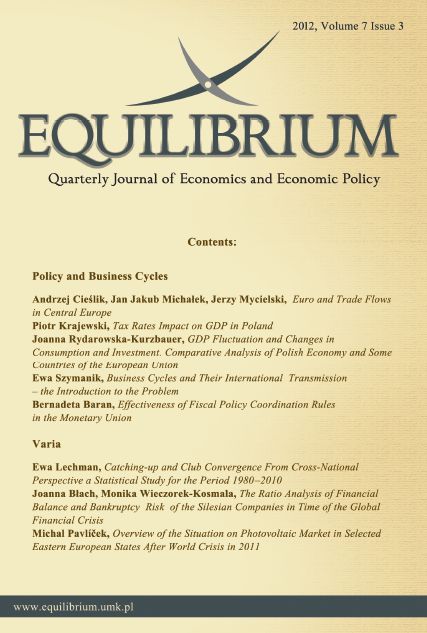Effectiveness of Fiscal Policy Coordination Rules in the Monetary Union
DOI:
https://doi.org/10.12775/EQUIL.2012.020Keywords:
fiscal rules, deficit, debt, fiscal policy coordinationAbstract
Stability and Growth Pact is the main rule-based framework for the coordination of national fiscal policies in the economic and monetary union (EMU). It was established to safeguard sound public finances, an important requirement for EMU to function properly. Member states had a lot of determination before setting up a monetary union (nominal criteria were a condition to adopt common currency). In the next years, coordination of fiscal policy was not so successful. In many countries, revenues were temporarily boosted by tax-rich activity, while they didn?t restrict their expenditures. In most countries fiscal policy was pro-cyclical (not anti-cyclical) and they didn?t achieve their MTO. Financial crisis has sharpened budgetary problems in member states and showed the weakness of coordination rules.
Downloads
References
Calmfors L. (2005), What Remains of the Stability Pact and what next?, Swedish Institute for European Policy Studies, No. 8
Feldstein M. (2005), The Euro and the Stability Pact, NBER Working Paper No. 11249.
Gros, D., Mayer T., Ubide A. (2004), The nine lives of the Stability and Growth Pact: A special report of the CEPS Macroeconomic Policy Group, Centre for European Policy Studies, Brussels.
Hallett H., Lewis J. (2005), European Fiscal Discipline Before And After EMU, Permanent Weight Loss Or Crash Diet? Vanderbilt University, Working Paper No. 05.
Momigliano S., Staderini A. (1999), A New Method of Assessing the Structural Budget Balance: Results for the Years 1995?2000, Indicators of structural budget balances, Banca D?Italia.
European Commission (2010), Council Decision of 13 December 1996 in accordance with Article 109 j (3) of the Treaty establishing the Cyclical Adjustment of Budget Balances, Autumn 2010.
European Community (1996), on entry into the third stage of economic and monetary union (96/736/EC).
European Commission (2010), General Government Data, Autumn 2010.
European Commission (2010), Cyclical Adjustment of Budget Balances, Autumn 2010.
EMI (1996) Progress towards convergence.
EMI (1998) Convergence Report.
Communication from the Commission, Enhancing economic policy coordination for stability, growth and jobs ? Tools for stronger EU economic governance, Brussels 30 June 2010, COM (2010) 367.
Council Regulation 2223/96 of 25 June 1996 on the European system of national and regional accounts in the Community, Official Journal L 310/1.
Council Regulation 1055/2005 of 27 June 2005 amending Regulation (EC) No 1466/97 on the strengthening of the surveillance of budgetary positions and the surveillance and coordination of economic policies, Official Journal L 174/1.
Council Regulation 407/2010 of 11 May 2010 establishing a European financial stabilization mechanism, Official Journal L 118/1.






